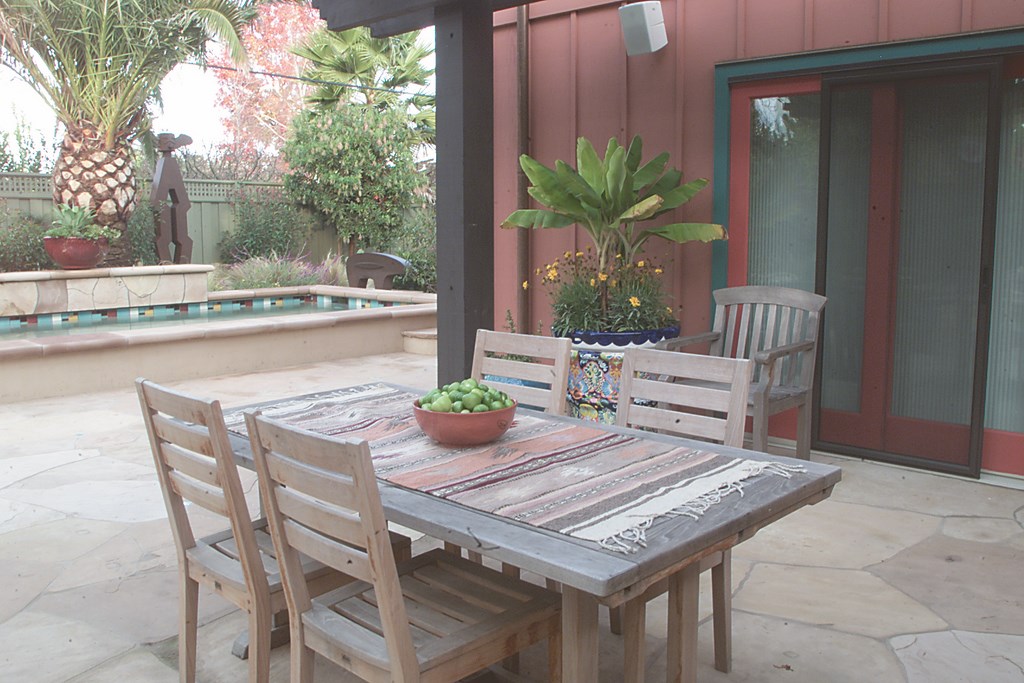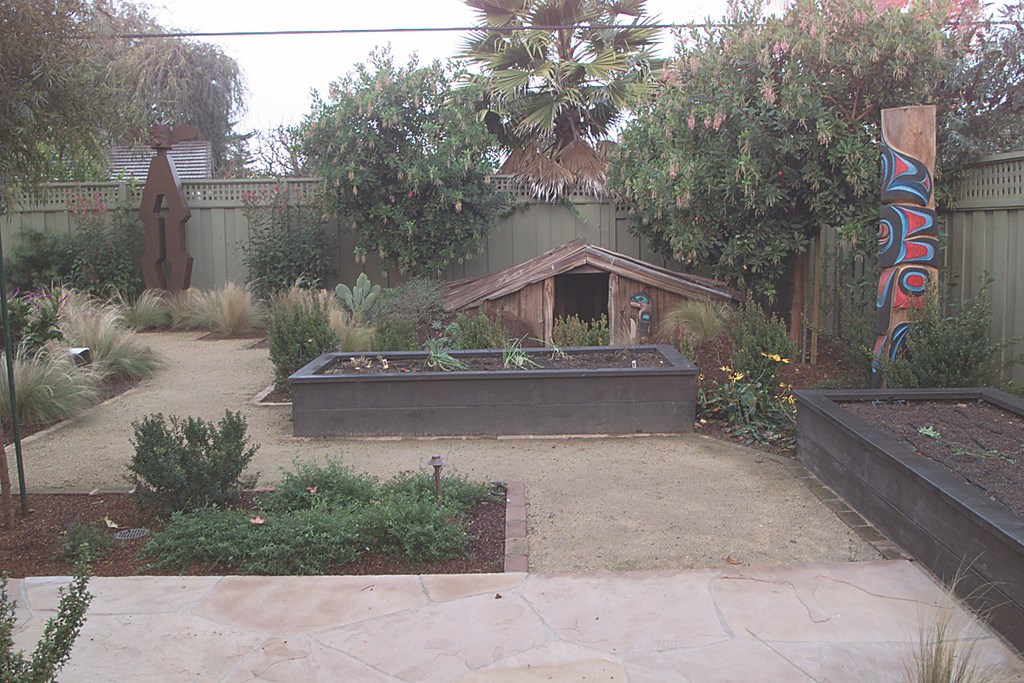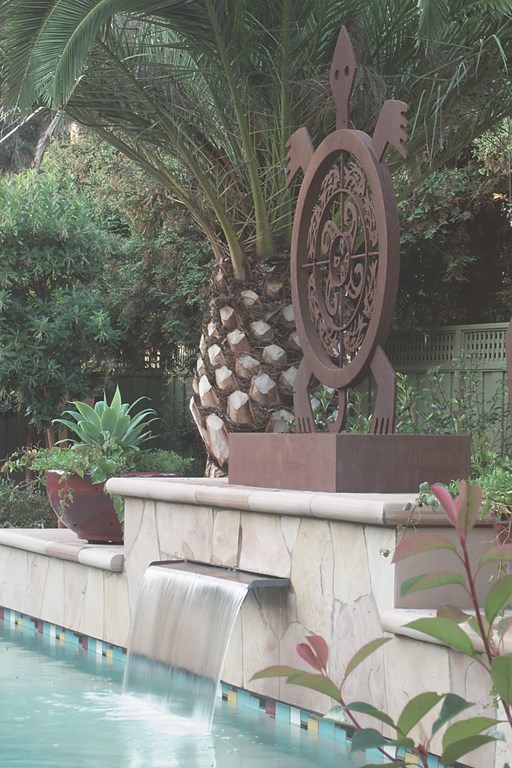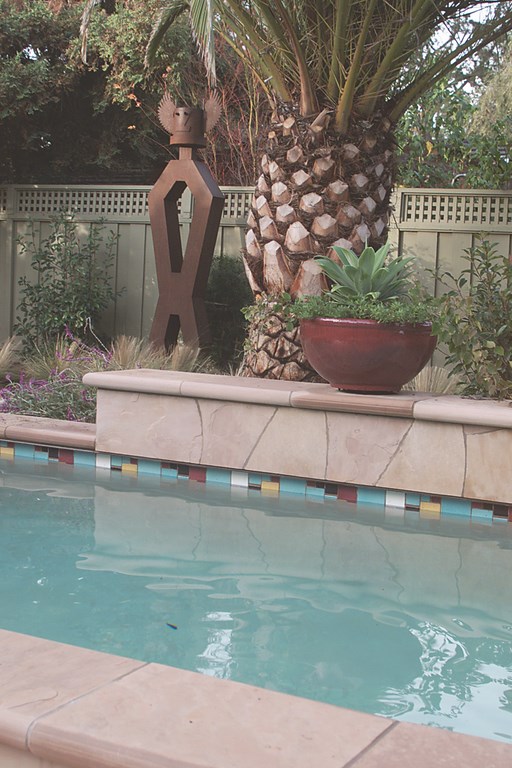A Taproot Manuscript
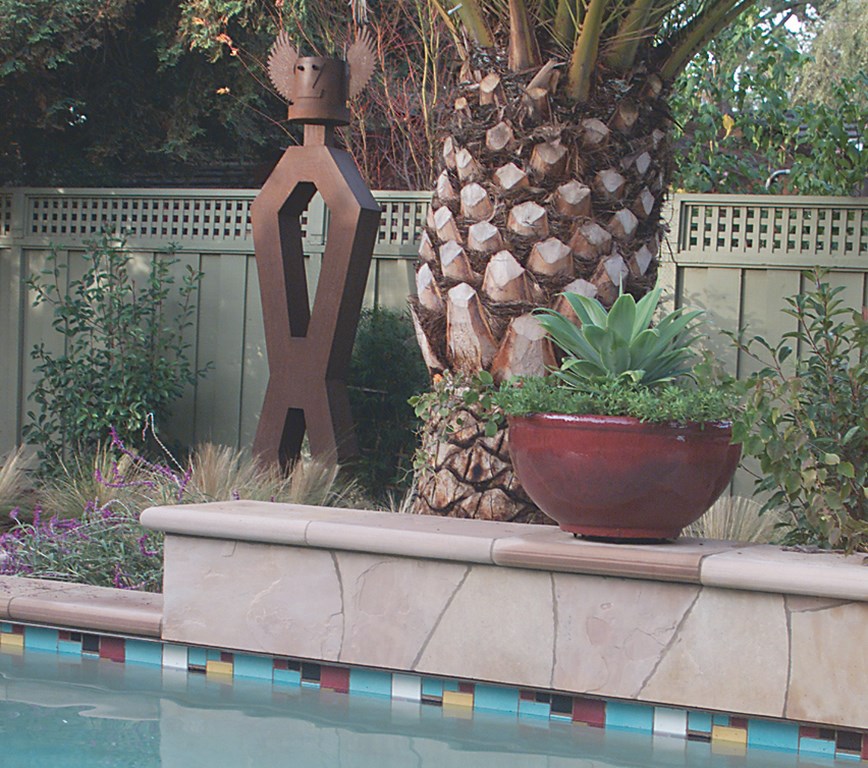
From the start, it’s been a project that has taken its direction from the art, spirit and cultural heritage of the clients and has always been much more to me than just another opportunity to design an attractive backyard and swimming pool.
I’ve always gravitated toward work that lets me treat spaces with a sense of spirituality and a respect for the energy and sanctity of nature that ultimately will resonate with clients beyond the purely visual and functional aspects of the design. Often, those qualities are expressed in subtle ways that I end up appreciating more than my clients, but in the case of the project seen here, there was a joy and ease to the work because the clients shared my sensibilities. As a result, the work encompasses a set of cultural, metaphorical and artistic overtones both bold and unreserved.
Their residence in Los Altos, Calif., is on a flat, one-third-acre suburban lot in a relatively unassuming (but affluent) neighborhood of large ranch homes on quiet streets. Even with a first impression, however, I knew this was not to be a typical project: The home stood out amid the staid landscapes with a colorfully chaotic rose garden out in front of a bright, terracotta-colored house with a large, Santa Fe-style covered porch filled with Mexican art and furnishings.
A multi-ethnic family of ample means, they were interested in finding places in the backyard for their growing collection of larger-than-life Native American sculptures and for various other expressions of the family’s heritage and tastes.
VISION QUEST
Being part Seminole, I felt a natural connection with their desires and an enthusiasm for helping to give expression to an often-overlooked culture. But they had a long wish list of ideas and features they wanted to include in the space – a setting that not only celebrated their various cultural roots, but also evoked memories of various settings they had enjoyed through the years.
So we set out together to create a sort of “spatial manuscript” in the forms of sculpture, culture, plant material and water.
| The courtyard offers gracious access to the space beyond, with the elevated lap pool making its first impression as a seating area rather than as a watershape. |
It was also apparent right from the start that these clients were in love with Native American and Mexican art. Their home featured walls dominated by brightly colored masks, Mexican folk art, Huichol Indian string paintings, original oil murals, dolls and Navajo rugs as well as rusted-iron sculptures set against bright stucco. A totem pole sat in the garage awaiting placement in the yard, and the husband’s arms displayed traditional Native American art in the form of bold tattoos. I was drawn to and inspired by this exuberance of expression.
And they were more than simply “collectors.” The art celebrated the family’s eclectic mix of backgrounds: the husband from the Muckleshoot tribe of the Pacific Northwest, two adopted boys – one from Walapai tribe of the southwest desert, the other of African/Native American descent – and the wife of European extraction. Interestingly, she was perhaps the most passionate of all about wanting to find ways to express and find harmonies in the family’s cultural complexity – and about expressing her love of art and fond memories of time she and her family had spent in Hawaii.
| The homeowners had a lengthy wish list for a relatively small backyard space, including a ceremonial sweat lodge and places for a growing collection of sculptures. |
The first thing we talked about was their outdoor art collection and their desire to put several sculptures on display. Many of these pieces were quite large (some up to eight feet tall), and most were by their friend, the artist Elwood Reynolds of Santa Fe, N.M. I was intrigued by the sculptures, especially one large turtle sculpture that I knew would eventually occupy a prominent place in the design.
As inspiring as the project was on a personal level, it was rather daunting on a practical one: Their punch list for the space – a meditation area, a sacred sweat lodge, a vegetable garden, shade areas, a barbeque, a fireplace, an outdoor shower, a totem pole, a pool house and a lap pool – was considerable given its small size. Then there was the fact that we were discussing the inclusion of three exotic ecosystems – the forested Pacific Northwest, the Southwestern deserts and tropical Hawaii – along with features familiar in temperate, coastal Los Altos.
CROSSING CONNECTIONS
At first, everything seemed want to fly apart, and I’ll concede that I was somewhat stumped when it came to visualizing a way to make it all work together.
For one thing, the earthen tones of a Native American style were more subtle than (and seemingly at odds with) the vivid, saturated colors of the Mexican artwork. For another, it was hard at first to conceptualize a lap pool evoking a Native American feel. To make things even more challenging, the canvas I’d been given kept changing: New large art pieces would occasionally arrive and, even though I might have initially suggested it, I didn’t expect them to add a two-story wing onto the house midway through landscape installation.
| It was tough at first to visualize the lap pool as part of this landscape, but before long it took on its own thematic and artistic dimensions and is now at the core of the overall composition. |
In all cases, however, solutions presented themselves. Even the addition to the house helped by enabling us to create a central courtyard that not only pulled the design together, but also provided a way to separate spaces and put the pool house in an inconspicuous place.
Our historical, cultural, and stylistic research also pointed us in certain key directions. For example, we kept with a roughly rectilinear pattern along the cardinal points of the compass – very important in Native American tradition. The sweat lodge, for instance, needed to face due east for ceremonial reasons.
The rectilinear grid enabled us to split the space into smaller, distinct ecosystems that were unified visually by use of the sacred colors of Native American tradition – black, white, turquoise, maroon and yellow – throughout the landscape.
|
The spillway serves to draw attention across the pool to the artworks beyond – and, once visitors enter the yard, lends soothing auditory sensations to the visual experience (left). The pathway along the fence and behind the pool (right) has become a “gallery walk” where some of the homeowners’ most dramatic artworks are on display. |
I was happy at the unifying symbolism, but I was also a bit apprehensive at first about how the colors really worked together. When I mentioned as an aside that I didn’t think these colors seemed to blend together very easily, the wife responded, “Maybe not to you, they don’t.” That response, early on, set me on a path to stretch my usual assumptions about what constitutes a harmonious color palette.
As things unfolded, I found that the plants, natural stone and materials of the surroundings softened the bold disparity of the colors. For the patios, we chose a random pattern of adobe brown/milk chocolate flagstones, and the various spaces were connected by golden decomposed-granite pathways. Much of the landscaping – particularly the ground covers and structural greenery – was kept subtle and neutral in tone, thereby creating a unifying visual baseline and backdrop for the artwork and sacred colors. (See the sidebar below for more on plant choices.)
WATER DANCE
As the design process moved forward, I was still challenged to figure out how to include a lap pool. Before long, I was saved by the recognition that I had to consider it as a dramatic waterfeature and as another one of the backyard’s works of art.
|
Planting Symbols Plant selection for this garden of disparate ecologies became a matter of balancing symbolism with practicality. The utility lines that cut across the yard prohibited the use of taller conifers, for example, so we used Arbutus ‘Marina’ to represent the Northwestern forests in place of the larger and hard-to-grow native madrones (A. menziesii). The cinnamon-colored bark tied in naturally and beautifully with the hues of the rusted-iron sculptures. To express the Hawaiian influence and add some drama near the pool, we installed two mature Phoenix canariensis palms, with their wide trunks and broad fronds. Indeed, all plants were chosen for place of origin, texture, use and, in some cases symbolic meaning. We planted white sage for use in the sweat lodge, for instance, with delicate Mexican feather grass along the path. To honor the salmon sacred to Pacific Northwest cultures, I used Justicia brandegeeana (shrimp plant) from Mexico for its salmon-colored, fish-shaped flowers. Huckleberry, Ceonothus, and Podocarpus gracilior espaliers were used as textural backdrops on fences stained a sage green, and an African box was used as a space divider. On the patio near the pool, we used colorful turquoise, gold, and red pots planted with banana and tropical-accent plantings. Further away from the pool, the pots hold Nolina recurvata of the deserts, while on the wall above the pool, Agave attenuata and cascading California Gold bougainvillea bring together the tropics and the desert. — C.H. |
We placed the pool at the center of garden, raising it 18 inches above grade for comfortable seating. We kept it rectangular – functional for lap swimming as well as harmonious within the rectilinear design space. At 35 by 10 feet, I felt it might be a bit short, but the clients have volunteered the observation that it works perfectly for both exercise and recreation.
Jeff Canderle of Canderle Pools (Santa Clara, Calif.) worked closely with Rick Myers (Myers Landscape, Granite Bay, Calif.) and a masonry team to solve the various construction challenges, including stabilizing the seven-foot-high turtle sculpture on the raised wall above the spillway. In the end, we all worked together to create a quality watershape that stayed true to the project’s artistic sensibilities.
The pool’s interior has a custom plaster mix. I wanted the water to look very natural while providing soothing reflections of the surrounding greenery and artworks, so I chose a soft beige/mustard blend – an earthy color that looks soft green when filled with water.
| The turtle is perhaps the most prominently positioned of all the sculptures now on display – something we visualized from the start of the design process. |
Of all the design details we included in this project, the pool’s ceramic waterline tile is probably my favorite. A great deal of time was spent looking at different tiles to be sure we had the right colors and tones. With so many to choose from, I was surprised with the difficulty we had in finding just the right shade of turquoise. In the end, we ordered a custom color that turned out beautifully and was well worth the extra time and trouble.
The tile pattern isn’t based on any traditional pattern. I preferred a contemporary interpretation and came up with a repeating sequence of square tiles of various sizes – six by six, four by four and three by three – that occupied lots of my time in finding just the right combination. Francisco Villa of Villa Landscape (Fremont, Calif.) contributed a valuable final touch to this design as well as providing expert installation.
We knew it would be important to combine the sacred colors and use the pool as a central, unifying feature for the space, and the tile turned out to be the perfect way to get the job done: The pool is now truly the garden’s focal point – centrally located, drawing the eye to the soothing water surface and providing visual points of departure for the Native American art seen throughout the yard.
WORK IN PROGRESS
Once our work was complete, all concerns about the pool being out of step with the rest of the environment were put firmly to rest. Indeed, what had once been seen as the most distracting of all possible elements in the design now serves a crucial role in pulling everything together.
The fact that the pool is raised offers another benefit: It provides for a somewhat secluded pathway on its far side that serves as a sort of “gallery walk” from which one can view the sculptures amid sounds of moving water, rustling grasses and swaying palm fronds.
| Unlike many of the project’s design elements, the tile pattern isn’t based on any traditional source, but the sacred colors were used quite deliberately to unify visual impressions across the entire space. |
But these are clients who will keep evolving and growing, so while we’re happy with what we’ve accomplished, we’ve come to see this project as an open-ended , developing work of art. In fact, the clients kept right on buying art as we worked, and I know they will continue to bring in more pieces, making changes to the space and adding their creativity for years to come. (At this writing, in fact, we’re in the process of adding a kiva fireplace and barbecue).
As a designer, I know I may never again run across clients with so developed a set of sensibilities and culture that harmonize so well with my own. The bottom line is that I received much inspiration from these clients, whose creativity and sense of the spiritual so infuse their everyday lives. Satisfying clients like these brings exceptional gratification, of course, but I received an unanticipated bonus when I heard that the sculptor, Elwood Reynolds, was moved by seeing the garden and his art so appropriately displayed.
Certainly a design challenge with any project is to understand and amplify a client’s ideas, but when the values behind their ideas resonate so strongly with your own, the work takes on a meaning and excitement that can be truly extraordinary.
Cynthia Hayes is owner and principal designer for Mozaic, a landscape-design firm established in 1991 and now located in Sunol, Calif. She received her Master’s in Landscape Design from the Conway School of Landscape Design in Conway, Mass. Much of her work is on residential projects, and some has been featured on tours and in publications – including a project that won a “Best in the West” award from Sunset in 1999. She has completed projects in settings from Berkeley, Sacramento and Palm Springs in California to Washington, Colorado and New Hampshire, to name a few, and has worked singly and collaboratively on master plans for large public projects. She enjoys working with contractors during the installation process and pursues a design process that aims to respect the site as a third party, encouraging clients to find peace and connections to nature within their own properties. She can be reached at [email protected].











